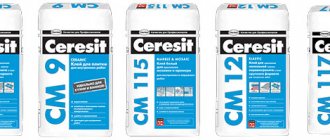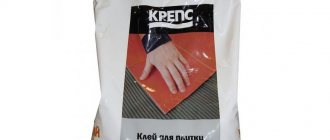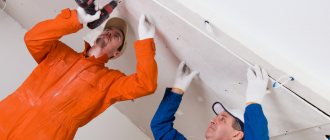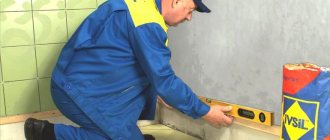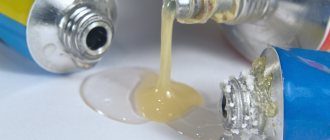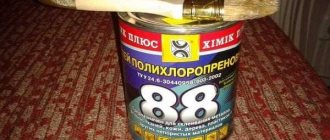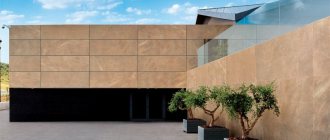The range of building materials in modern stores is so diverse that it is difficult to say for sure whether it is good or bad.
On the one hand, of course, the more choice, the better, but on the other hand, abundance increases the risk of mistakes: you can buy the wrong material or overpay...
The risk of making a mistake when choosing tile adhesive is especially high. The situation is complicated by the fact that manufacturers do not always indicate the composition of the glue on the packaging.
Types of compositions
Two main groups can be distinguished:
- ready-made mixtures in the form of pastes;
- dry compounds.
Ready-made paste adhesives are sold in small buckets. They are characterized by homogeneous mass, low consumption and high adhesion. Such adhesives can cope with difficult areas and substrates, but the high cost forces the use of pastes sparingly and selectively.
Dry compounds are cement-based adhesives, sold in bags of various packaging. Before use, you need to prepare the tile adhesive according to the instructions.
Depending on the content, adhesives are divided into groups:
- cement-based;
- epoxy;
- dispersive;
- polyurethane.
Next we will tell you about each group in more detail.
Cement based
Sold in bags in the form of dry powders. Cement-based adhesives consist of Portland cement, sand and modifying additives. Additives make up less than 5% of the total composition.
Sand in the tile adhesive adds strength to the solution and reduces its weight, and, consequently, the load on the base.
The modifiers included in the tile adhesive determine the properties that the adhesive composition has in its finished form.
- Plasticizers - the solution has greater fluidity and plasticity.
- Anti-frost additives - tile adhesive will be frost-resistant, used for outdoor work.
- Water-retaining additives - the solution will retain moisture longer and have greater strength. The concept of heat resistance of glue is based on these indicators.
Cement compositions are divided into two types:
- thin layer adhesives;
- thick-layer adhesives.
Thin-layer mixtures are used for laying on the base with differences of up to 1 cm.
Thick-layer adhesives are used to level minor differences - from 1 to 3 cm. So you don’t have to plaster the walls, but level them with tile adhesive. Consists of cement and polymer additives that increase the strength of the composition.
Two-component epoxy compounds
Epoxy adhesives consist of epoxy resin and a hardener. The two components must be mixed before use. The resin itself does not have the strength and required fluidity; the hardener will give it the required strength and pressure resistance. The advantage of the material is that epoxy adhesives have high adhesion; they glue ceramics to a wooden or metal base.
Variances
Sold in the form of a ready-made paste, they have a homogeneous mass and thick consistency. Must be mixed before use. It is used for both wall and floor tiles, which are laid on smooth concrete, plaster and plasterboard bases.
They consist of an aqueous dispersion based on acrylic, latex or polyvinyl acetate.
Polyurethane compounds
They are distinguished by their elasticity; they glue any two types of surface, for example, metal and glass. Suitable for working with ceramics in difficult areas. There are one-component and two-component polyurethane-based mixtures.
They also provide additional waterproofing.
The one-component composition acquires hardness due to exposure to surrounding moisture, which enters into a chemical reaction with the components of the solution.
In the second case, you need to mix the components of the solution in the correct ratio specified in the instructions. Then the glue will be strong, elastic and resistant to temperature changes.
note
Please note: Some polyurethane compounds expand after curing. They are not suitable for laying ceramics.
Cement tile adhesives are used most often in construction; the optimal price-performance ratio explains the popularity of the material. Cement mortars have a higher consumption, but the low cost makes it possible to have such a consumption.
How to make tile adhesive with your own hands - recipe
It is very important to know the approximate composition of tile adhesive if you want to make it yourself. Of course, the easiest way is to buy it in a specialized store, but what to do if work is in full swing, and all construction stores are no longer open?
It is in this case that understanding how to make tile adhesive yourself according to a recipe will come in handy. First, make sure you have the basic glue ingredients:
- Cement – brand M-400 is suitable.
- Sand.
- Wallpaper glue or regular PVA glue.
Naturally, we will also need containers for mixing the components , as well as various tools. The manufacturing process will look like this:
- First you need to dilute the wallpaper glue with the amount of water indicated on the package. Remember that maintaining proportions is very important for the correct consistency of the glue;
- Next we need sand. You can buy it at a hardware store, telling the seller that you need sand, the fractions of which should be about 2 mm. If required, sift the sand;
- then mix sand and cement. Here you also need to observe proportions: one part of cement will require three parts of sand;
- Our task in preparing glue is to achieve the consistency of thick sour cream . That is why diluted wallpaper glue should be added to the cement-sand mixture in portions. First, you can pour in one glass, then stir the solution and, if necessary, pour in more wallpaper glue;
- then you can move on to testing. We apply the composition to the tile, and then apply it to the surface. If the glue adheres well to it, and it is of sufficient consistency to allow you to move the tiles along the wall, then we have done everything right.
If something doesn’t work out, then the required consistency can be achieved by adding dry mixture or water .
For more information about making homemade glue, watch the video:
Eunice
Eunice tile adhesive is in quite high demand, which is explained by its decent hardening characteristics, as well as its quite affordable cost.
The composition of Yunis tile adhesive includes a standard set in the form of cement, a special filler and chemical elements. Another important component is ordinary water, which is used to dilute the dry mixture.
So, a 25-kilogram bag will require about five liters of liquid.
Eunice
The adhesive is applied to the tiles in a layer of approximately 1.5 cm, which allows you to use it quite economically. On average, 4 kg of mixture is used per square meter.
The scope of application of Eunice glue is quite wide. It can be used on surfaces such as asphalt, plaster, brick, concrete, etc.
Remember that after preparing the glue, it must be used within 4-5 hours, otherwise it will lose all its properties.
Technical characteristics of the solution during and after working with it
During operation, a high-quality tile mortar should be:
- elastic, that is, it fits well on different surfaces;
- have a long lifespan, which will allow you to work with the mixture for a sufficient time after preparation;
- with high adhesion, which will ensure reliable fixation of the cladding to the base;
- with low fluidity, which will prevent the tiles from slipping when laying them on the walls.
After laying and setting, the mortar must be strong, resistant to compression of the cladding and attempts to shift.
According to GOST, the strength of a frozen mortar is measured in MPa; for universal compositions the figure is 10 units, and for elastic mixtures and products labeled “For reliable fixation” - 15 MPa.
- frost-resistant;
- moisture resistant;
- heat resistant;
- elastic – able to withstand temperature deformations of the tile.
The technical indicators listed above depend on the type of mixture and manufacturer.
What does the choice depend on?
As you might have guessed, there is no single best glue that can be used absolutely always. The choice depends on several factors:
- tile type and size;
- type of base;
- operating conditions (indoors or outdoors, high humidity, high temperatures, etc.);
In any case, a good tile adhesive should be flexible and have high adhesion rates.
Types of glue depending on purpose
- Universal - positioned as a composition for external and internal work. The solution can handle ceramics and porcelain stoneware and is used to perform work without special conditions.
- Reinforced – characterized by increased strength, moisture resistance and elasticity. Used for laying large-format floor tiles, for example, 120x120 porcelain tiles. Suitable for tiling in rooms with heavy traffic or where heavy furniture, etc. will be placed on the tiles.
- Moisture resistant - the cement adhesive composition contains modifiers to increase moisture resistance and additives to resist mold and mildew. Adhesives are used for tiling bathrooms, showers, baths, saunas - rooms with high humidity.
- Glass mosaic adhesive – for mirror and transparent mosaics, a white cement-based solution is used. All other adhesives would bleed through the mosaic, so white solutions are needed.
- Frost-resistant – anti-frost additives have been added. Only this kind of glue can be used for exterior work: for finishing the facade, lining steps, porches, etc.
Ceresit brand products have proven themselves well; the manufacturer has provided a line of tile adhesives of all the types listed above.
Another popular and popular brand was Knauf. The products are characterized by low consumption, excellent adhesive properties, and durability.
Special properties of glue
When it comes to laying tiles in particularly important places or places with specific conditions, you can take a composition with special properties:
- Heat-resistant compounds are necessary when lining stoves and fireplaces; they can withstand temperatures above 1000C. They are also used together with a heated floor system, but in this case it is also necessary to take elastic glue;
- quick-drying adhesive thanks to special additives makes it possible to use the lined surface within 3-4 hours;
- waterproof glue is recommended for use in swimming pools, bathtubs, porches, open balconies, and terraces. All epoxy adhesives are completely moisture resistant, but are expensive. There are cement compositions that, thanks to additives, are also given moisture-resistant properties, but such adhesives are not cheap. Craftsmen advise, where possible, to use regular glue and grout with moisture-resistant compounds;
- frost-resistant adhesives are suitable for simple substrates and quickly lose their plasticity;
- acid-resistant adhesives are used in laboratories, industrial plants and other premises where exposure to aggressive agents is possible. Such compositions have sufficient moisture resistance, are odorless and harden quickly.
On sale you can also find special adhesives for heated floors, swimming pools, leveling adhesive (for laying on a very uneven base), glue with additional insulation and white glue for transparent and translucent mosaics.
Universal adhesives, as the name suggests, can be used everywhere, but this is not the case. They are not suitable for heated floors, for installing porcelain stoneware, and often cannot be used for external cladding. Versatility is adaptation to average operating conditions, and such conditions do not always exist in real life.
Consumption and drying time
The composition consumption is indicated on the packaging with the material. Consumption may be more or less depending on weather conditions, base curvature, professional skills and type of tile.
The packaging also contains similar professional terms:
- Adjustment time – tiles can be adjusted after laying on the mortar;
- Open working time - the time from applying the solution to the base until it sets; Long operating time allows you to apply glue over a large area at once.
- Suitability time for work - from preparing the solution to setting.
For urgent work, choose a material with minimal adjustment time, but for a novice master, this is just the thing.
What are we paying for?
Indeed, if the composition of tile adhesive is so simple, then why do prices vary so much and is there any point in paying more? Many specialists in the field of construction and renovation prefer to prepare tile adhesive themselves, purchasing only the “ingredients”.
But for amateurs, this approach can end sadly - with the tiles falling off... well, if without damaging the base.
On your own, without special knowledge, it is difficult to choose the correct weight ratio of the adhesive components, which reduces the quality of the adhesive mass, worsening its characteristics and properties, primarily adhesion, on which the density of adhesion of the tile to the surface depends.
There is an opinion that the more expensive the glue, the more modifying additives it contains, and, accordingly, the better the properties of the glue. This is also a kind of “myth” - too high a price for tile adhesive is not a guarantee of quality - there is a high probability of simply overpaying for the “brand”.
Therefore, choose tile adhesive of the “average” price category of a trusted brand, since well-known manufacturers comply with all the requirements of quality standards and guarantee the safety of materials both when working with them and during further use.
Storage and preparation of cement tile adhesive
- When purchasing, look at the expiration date of the material and the date of manufacture.
- You can store tile adhesive in a dry room or outdoors in warm weather and under a canopy.
noteIf bags are stored in a humid environment, the powder will absorb moisture, which will impair adhesion, ductility and other characteristics of the solution.
- You can prepare the tile solution manually or with a construction mixer. Using a mixer, you can achieve a homogeneous mass without lumps and the desired consistency.
- You can work with the solution at temperatures from +5 to +
Basic rules at work
So that the rules do not look like general recommendations, let us take as an example adhesive compositions containing cement. In order for the composition to set properly and also retain all its properties on the surface, the following nuances must be observed:
- the room must have an acceptable temperature for work . To stick the tiles, it must be in the range of 5 to 30 degrees Celsius;
- It is necessary to maintain the correct amount of water when diluting the glue. On average, to obtain a normal consistency you will need about five liters of water per 25 kg bag;
- You need to apply the correct amount of compound to the tiles. As a rule, 3-15 mm of glue is applied;
- The average lifespan of glue, so to speak, is 3-4 hours. At the same time, after gluing the tile to the surface, we will still have about 10 minutes to adjust the position of the tile;
- As for the hardening time, it is about 24 hours , after which you can safely walk on the tiles or perform any other manipulations.
An adhesive that is made for tiles made from tile and ceramic materials
It is quite possible to prepare the tile mortar yourself. At the same time, it will be possible to glue the facing surface onto it without fear.
This mixture should include:
- packaging of a foam plastic block 20x20x20 mm;
- acetone.
In order to glue the tile, you need to turn it over with its back side. Consequently, foam is placed at the corners of the tiles and acetone is dripped onto each edge. Further, the tile composition tends to set on its own. This process occurs after a few seconds, due to the fact that the foam dissolves under the influence of the substances used. Thus, the resulting solution tightly adheres the tiles to the wall.
The technology for preparing a solution for gluing walls with ceramic tiles requires the same components as for tiles. But here it is necessary to prepare a special solution, which will have a ratio of 1:4 by volume. For more plastic properties of the solution, lime should be added to its composition. It should be no more than 1/5 of the total volume.
Note! It is strictly forbidden to add gypsum to the cement mortar, because the mixture will lose all its adhesive properties and the tile cladding will not adhere to the wall or floor.
As a rule, they contain
- Organic and mineral substances (this includes cement, lime, quartz sand, cobalt sulfate, etc.).
- Various polymer additives (provide frost-resistant properties, help restore properties after the mixture has been diluted with water).
- Plasticizers and thickeners (used to ensure plasticity and elasticity of the adhesive joint).
- Substances of a synthetic and mineral nature, for example, magnesium, aluminum or calcium, which increase the level of resistance of the mixture to moisture and adhesion).
As well as cellulose ether, which provides the material with the required level of viscosity.
Adhesives for outdoor use
Due to the fact that most consumers use tiles for exterior finishing work, it is necessary to buy adhesive that is recommended.
Tile coverings made from natural materials, as a rule, weigh more, due to which it creates additional load and the need to select a fastening system with a higher level of strength.
At the same time, artificial tiles, despite being lighter in weight, also require a reliable method of fastening.
Therefore, there is no universal advice on choosing tile adhesive with frost-resistant properties; in each specific case it is necessary to choose the most suitable one, and besides, the modern market provides a fairly wide choice.
What can replace tile mortar?
Before replacing the tile adhesive solution with mastic or construction adhesive, it is necessary to prepare the base of the walls and floors for the tiles.
It is better not to replace the tile mortar with anything, because it has all the necessary characteristics for high-quality gluing of the facing material.
Sasha asked a question:
I decided to lay the tiles in the kitchen myself, but I don’t want to spend extra money. At home there is a bag of cement left over from filling a hole in the garage. Please tell me how to make tile adhesive with your own hands so that it is no worse than the adhesive mixture from the store.
Anyone who has planned a home renovation is trying to save on building materials and prepare an adhesive mixture for tiles with their own hands. I will tell you a recipe that I myself have repeatedly used for laying tiles.
